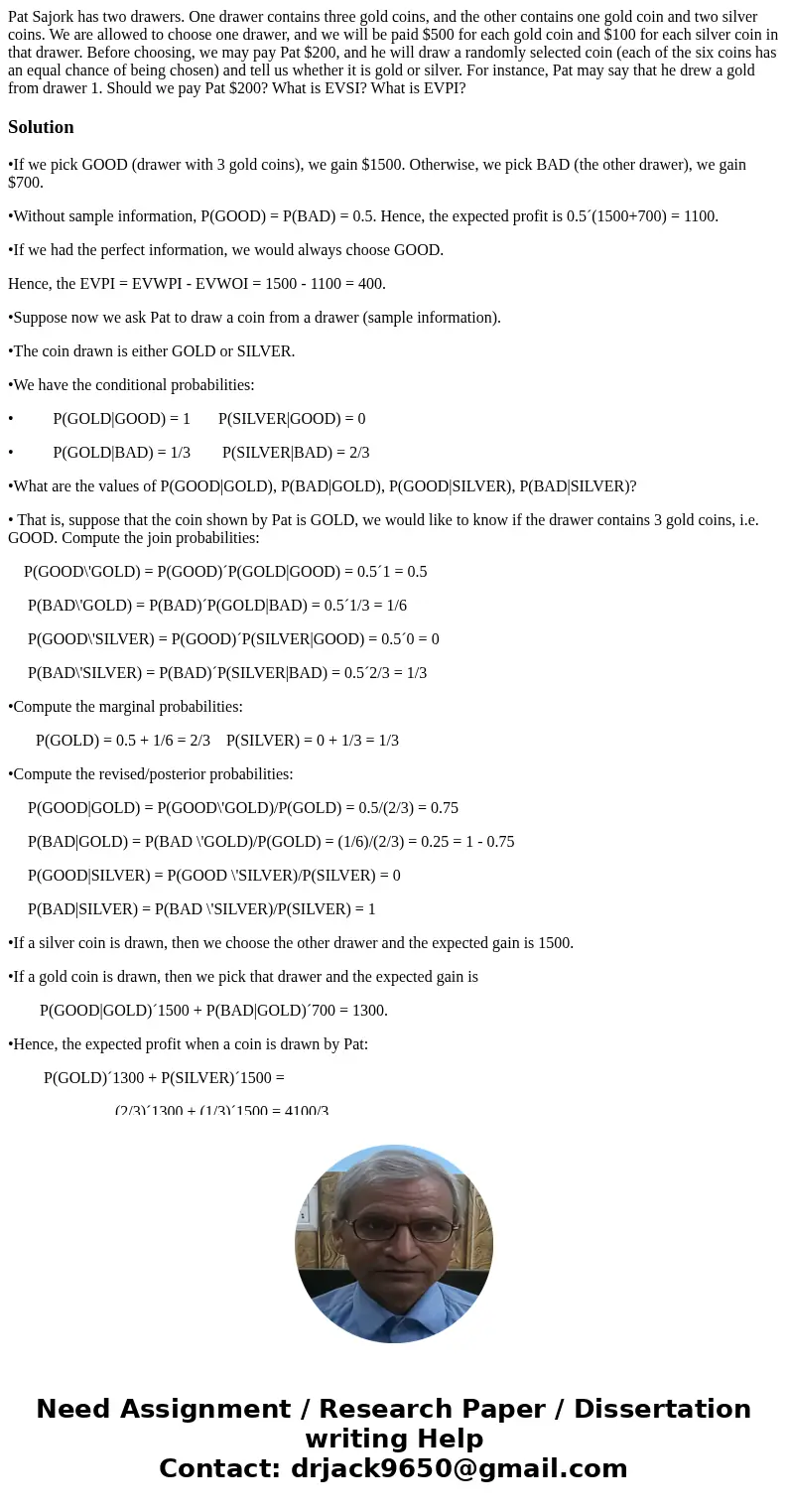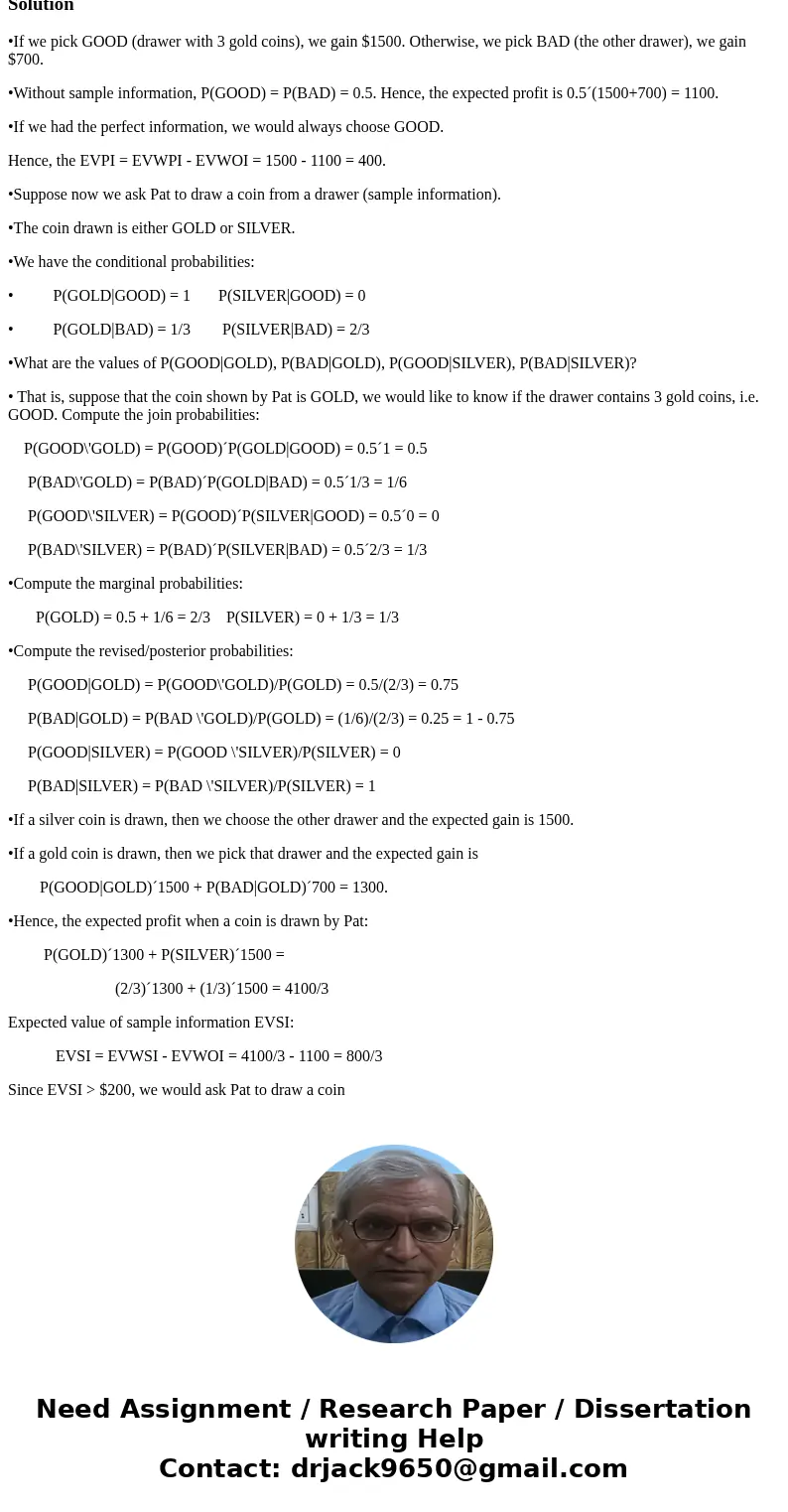Pat Sajork has two drawers One drawer contains three gold co
Pat Sajork has two drawers. One drawer contains three gold coins, and the other contains one gold coin and two silver coins. We are allowed to choose one drawer, and we will be paid $500 for each gold coin and $100 for each silver coin in that drawer. Before choosing, we may pay Pat $200, and he will draw a randomly selected coin (each of the six coins has an equal chance of being chosen) and tell us whether it is gold or silver. For instance, Pat may say that he drew a gold from drawer 1. Should we pay Pat $200? What is EVSI? What is EVPI?
Solution
•If we pick GOOD (drawer with 3 gold coins), we gain $1500. Otherwise, we pick BAD (the other drawer), we gain $700.
•Without sample information, P(GOOD) = P(BAD) = 0.5. Hence, the expected profit is 0.5´(1500+700) = 1100.
•If we had the perfect information, we would always choose GOOD.
Hence, the EVPI = EVWPI - EVWOI = 1500 - 1100 = 400.
•Suppose now we ask Pat to draw a coin from a drawer (sample information).
•The coin drawn is either GOLD or SILVER.
•We have the conditional probabilities:
• P(GOLD|GOOD) = 1 P(SILVER|GOOD) = 0
• P(GOLD|BAD) = 1/3 P(SILVER|BAD) = 2/3
•What are the values of P(GOOD|GOLD), P(BAD|GOLD), P(GOOD|SILVER), P(BAD|SILVER)?
• That is, suppose that the coin shown by Pat is GOLD, we would like to know if the drawer contains 3 gold coins, i.e. GOOD. Compute the join probabilities:
P(GOOD\'GOLD) = P(GOOD)´P(GOLD|GOOD) = 0.5´1 = 0.5
P(BAD\'GOLD) = P(BAD)´P(GOLD|BAD) = 0.5´1/3 = 1/6
P(GOOD\'SILVER) = P(GOOD)´P(SILVER|GOOD) = 0.5´0 = 0
P(BAD\'SILVER) = P(BAD)´P(SILVER|BAD) = 0.5´2/3 = 1/3
•Compute the marginal probabilities:
P(GOLD) = 0.5 + 1/6 = 2/3 P(SILVER) = 0 + 1/3 = 1/3
•Compute the revised/posterior probabilities:
P(GOOD|GOLD) = P(GOOD\'GOLD)/P(GOLD) = 0.5/(2/3) = 0.75
P(BAD|GOLD) = P(BAD \'GOLD)/P(GOLD) = (1/6)/(2/3) = 0.25 = 1 - 0.75
P(GOOD|SILVER) = P(GOOD \'SILVER)/P(SILVER) = 0
P(BAD|SILVER) = P(BAD \'SILVER)/P(SILVER) = 1
•If a silver coin is drawn, then we choose the other drawer and the expected gain is 1500.
•If a gold coin is drawn, then we pick that drawer and the expected gain is
P(GOOD|GOLD)´1500 + P(BAD|GOLD)´700 = 1300.
•Hence, the expected profit when a coin is drawn by Pat:
P(GOLD)´1300 + P(SILVER)´1500 =
(2/3)´1300 + (1/3)´1500 = 4100/3
Expected value of sample information EVSI:
EVSI = EVWSI - EVWOI = 4100/3 - 1100 = 800/3
Since EVSI > $200, we would ask Pat to draw a coin


 Homework Sourse
Homework Sourse